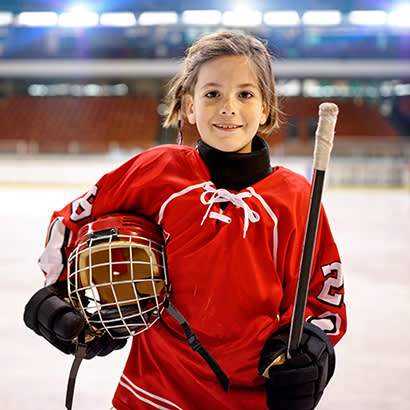
For an enhanced digital experience, read this story in the ezine.
Organized and unorganized sports are a critical starting point in a young person’s lifelong journey toward an active and healthy lifestyle. Youth who engage in sports not only grow up more physically active, but also gain mental and social health benefits that follow them into adulthood. Research demonstrates that children engaged in youth sports are less likely to experience obesity, report lower levels of depression and perform better academically. According to the Aspen Institute’s Project Play, participation in sports provides youth with increased opportunities to cultivate personal development and socioemotional skills, such as self-esteem, goal setting, positive communication and leadership.
Despite the benefits of youth sports, these outcomes are not guaranteed for all kids. Many youth — particularly girls, LGBTQ+, Black, Indigenous, youth of color, youth living in low-income communities, and youth with disabilities — face additional barriers in accessing quality sports opportunities.
Park and recreation professionals have the unique opportunity to be champions for inclusion in their communities, ensuring all kids can participate in meaningful sports opportunities that support their healthy development. According to an NRPA survey, 86 percent of park and recreation professionals believe it is their responsibility to contribute to a fair and just future by identifying and addressing inequities in access to youth sports. During the return to play following the coronavirus (COVID-19) pandemic, which further exacerbated inequities in access to physical activity, we encourage the field of parks and recreation to center equity and inclusion as we welcome youth back into sports.
NRPA spoke with colleagues from Special Olympics to uncover strategies promoting the inclusion of youth with disabilities in sports. As park and recreation agencies look to provide sports opportunities during and after COVID-19, they should follow guidance from the Centers for Disease Control and Prevention (CDC) outlining safety measures to prevent the spread of COVID-19.
Promoting Inclusion in Youth Sports
Embodying inclusion demands that no one is excluded or required to face additional rules or scrutiny to fairly and fully participate. Inclusive behaviors in youth sports provide opportunities and options to kids of all backgrounds, ages and abilities. Children who have a disability are 4.5 times less active and have obesity rates that are 38 percent higher than other youth, but often the biggest barrier for these youth is simply a lack of awareness about how to engage children with various abilities in physical activity.
Recognizing that young people with disabilities do not often get a chance to play on their school’s sports teams, Special Olympics champions the Unified Sports program to connect people with and without intellectual disabilities (ID) on the same team. This scalable social sports model brings together teams of similarly aged kids to practice and experience games that are challenging but fun in nature.
Park and recreation professionals can be champions of unified sports models by offering opportunities for people of all backgrounds, ages and abilities to participate together. Through local Special Olympics programs, park and recreation professionals can receive education and training on the various inclusive sports programs they can offer in their community.
The Impact of Youth Sports on Athletes
Sports help athletes deal with the highs and lows of life, helping kids learn about losing, winning and channeling emotions. Sports also foster a sense of belonging outside of school and the nuclear family.
Research suggests that organized social activities, such as sports, can help facilitate social involvement of people with ID in the community. Because Unified Sports provides people with and without ID the opportunity to play on the same sports team, they create a space for friendships, physical activity and fun that might not have existed otherwise. “After we came back from our first [Unified Sports event], I saw kids interacting in the hallways, either just saying hi or giving a high five. And normally, these kids wouldn’t even talk to each other,” says a Special Olympics coach in Florida.
Why Inclusion in Sports Is Important
Even before mandated physical distancing began due to COVID-19, it was recorded that almost 10 percent of people ages 16 to 24 considered themselves “always or often” lonely. In individuals with an ID, the average loneliness prevalence was 44.74 percent.
Now more than ever, it is essential that young people have the foundations of meaningful relationships, social connections and lasting support, so that they feel equipped to handle difficult times. These foundations not only support them during social isolation but also prepare them for the discomfort that may come with reintegration into normal life.
By creating meaningful and inclusive friendships, young people are taking steps to ensure social isolation — and the mental and physical health risks associated with them — is less prevalent. This means that children with and without IDs who feel supported may have longer, healthier and higher-quality lives.
For more information about inclusive health within parks and recreation, visit nrpa.org/ParksForInclusion.
Teresa Morrissey (she/her) is a Program Manager of Park Access at NRPA. Maureen Neumann (she/her) is a Program Manager of Health and Wellness at NRPA.

